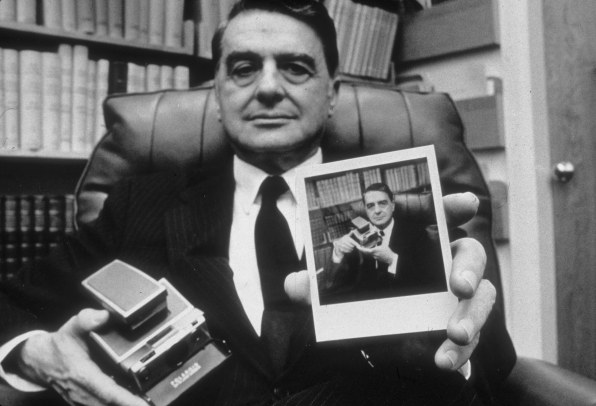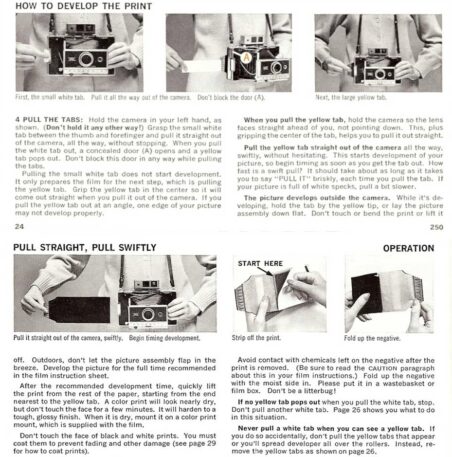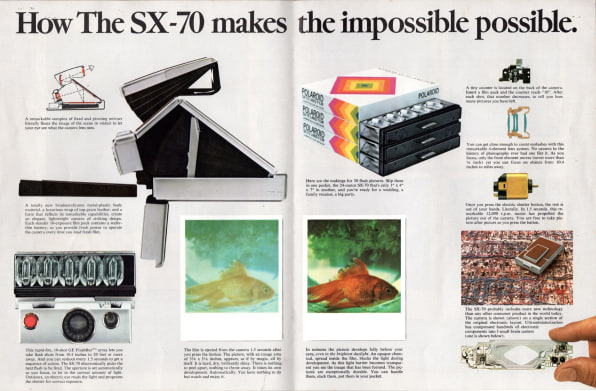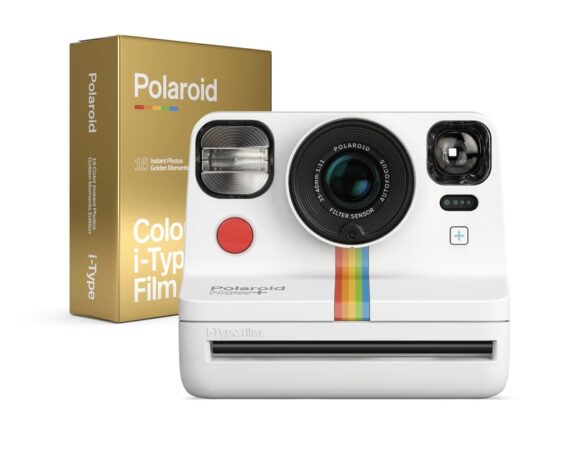- | 2:00 pm
As Polaroid’s SX-70 turns 50, instant photography is booming
Digital cameras and smartphones are great. But photo prints that develop before your eyes? That was downright magical in 1972—and still meaningful today.

Fifty years ago today, photography changed forever. The 3,000-something people assembled at a Polaroid warehouse in Needham, Massachusetts were the first to hear the news—from Polaroid founder/president/resident genius Edwin H. Land himself, who declared it to be a turning point for the medium.
Land was presiding over Polaroid’s annual meeting on April 25, 1972, and the change he was talking about came in the form of the company’s newest instant camera. It was indeed a transformative advance on its existing products.

Polaroid founder/president Edwin Land shows off the SX-70–and a Polaroid of himself—in November, 1972 [Photo: Joyce Dopkeen/New York Times Co./Getty Images]
The camera in question was eventually known as the SX-70, though that was just a code name in April 1972; Land told his audience it might be named “The American.” I have called it the greatest gadget of all time and once wrote a 14,000-word article making that case. You are free to disagree. But it was packed with innovations—many of which were the result of Land’s own brainstorms and breakthroughs—and they spanned chemistry, mechanical engineering, and electronics in a way that has no modern counterpart.Among the SX-70’s wonders is its enduring resonance. Analog instant photography once appeared to have been rendered hopelessly obsolete by digital photography. Yet it’s alive and well in 2022. Millions of people are taking photos with vintage Polaroid cameras, modern Polaroid cameras, and non-Polaroid instant film cameras. And they all owe their very existence to the technologies the SX-70 pioneered.

No previous camera looked anything like the SX-70; only a handful of later Polaroid models even resembled it. (This particular SX-70 is mine—restored to proper working condition and near-mint sheen.) [Photo: Harry McCracken]
FROM MANY STEPS TO ONE
When Polaroid released its first camera in 1948, it ushered in the era of instant photography. However, for the medium’s first 24 years, it was only so instant. Taking a Polaroid involved steps such as getting the knack of pulling a sandwich of paper, chemicals, and film out of the camera, carefully timing its development, and then peeling apart the sandwich to reveal a photo. Depending on the film type, you might have had to swab the print with a protective coating or attach it to a cardboard mount to prevent curling. Then you had to figure out what to do with the gooey chemical-laden paper left behind by this process.

This manual excerpt shows some—but not all—of the steps involved in using a typical pre-SX-70 Polaroid camera.
At the annual meeting, Land showed off a camera that offered what he called “absolute one-step photography.” You focused the camera and pressed the shutter button. With a whir of the camera’s motor, the photo appeared through a slot on the front and began to develop before your eyes. There were no development logistics to master, no clock to watch, no detritus to wrangle. Land demonstrated all this by snapping five photos in less than ten seconds, an impossibility with older models.
Much of the camera’s magic was in the photo—especially the pod of chemicals that spread as it exited the camera, allowing the picture to develop without benefit of a darkroom or even the paper cover of previous Polaroids. But the camera itself was also new in virtually every possible way. Encased in classy brown leather and chrome, it folded down into a 1″-thick brick that—unlike earlier Polaroid cameras—was compact enough to fit in a pocket. (Well, at least a particularly roomy one: At Polaroid, rumor had it that Land was wearing a jacket tailored for the purpose.) Unfolded, its oversized viewfinder showed you exactly what the camera’s lens saw, thanks to internals that bounced the image around to reach your eye. Land boasted of the electronics it packed to simplify picture-taking: a then-staggering three hundred transistors.

Folded up, the SX-70 was small enough to fit in a (really) large pocket. [Photo: Harry McCracken]
In short, if earlier Polaroid cameras had been BlackBerrys, the SX-70 was instant photography’s iPhone. Actually, it’s hard to think about the camera without drawing comparisons with Apple’s greatest product launches—especially since Steve Jobs idolized Edwin Land and his approach to invention. “Land was always focused on the consumer—on making it simple, putting the complexity inside the product,” says my friend Phil Baker, who worked on the SX-70 as a young Polaroid engineer and attended the annual meeting where it debuted.

Like Apple, Polaroid wasn’t shy about making lofty claims for its products in advertising materials.
Land’s April 1972 presentation was not quite a full reveal. Along with not having the camera’s official name ready, he held back on some technical details—for instance, each film pack contained its own battery, so the camera would never run out of juice at an inopportune moment. Though the unveiling included elaborate demo stations at which audience members could watch Polaroid employees use cameras to shoot a variety of subjects—kids, flowers, ducks, clowns—attendees were not allowed to touch the photos. Polaroid didn’t want any to make their way into the hands of anyone who might reverse-engineer how the technology worked—most obviously Kodak. (The photographic behemoth had been toying with introducing its own instant cameras for years, and would do so in 1976.)

On the cover of a Polaroid brochure, an SX-70 peeks intriguingly from its carrying case.
Then there was the fact that the Polaroid, which was still working kinks out of the camera and its production process, didn’t plan to put its new camera on sale until the 1972 holiday season. Then it blew that deadline. The SX-70 saw only limited release that year—just in Miami—and the full rollout was pushed back until the fall of 1973.
Even once it was available, the camera wasn’t an instant blockbuster: At $180, or about $1,200 in 2022 dollars, it was a luxury item, not a necessity for the masses. It still attracted enormous attention, including cover stories in Life and Time that lavished praise on, as Life put it, “a genius and his magic camera.”
Over the years that came, Polaroid introduced additional cameras based on SX-70 technology that were usually less elegant and ambitious, but also much cheaper—most memorably 1977’s $30 rainbow-striped OneStep. It also built on what it created with better, faster-developing film and new camera features such as sonar autofocusing and built-in flash. The SX-70’s various offspring became some of the most ubiquitous consumer electronics products ever. And the unique photos they took—unusually vivid but not all that sharp, with an almost-square aspect ratio and enlarged border at the bottom where the chemical pod resided—were a powerful Polaroid branding asset in themselves.
But eventually, things went south. Don’t blame digital photography—Polaroid began to falter in the 1980s, as slick point-and-shoot 35mm film cameras flooded the market and one-hour photo labs let people get their snapshots back with hardly any wait. Land—whose final gambit to revolutionize photography, 1977’s Polavision instant home movies, flopped—left the company in 1982. His successors presided over years of new products that largely rehashed past glories, leaving Polaroid in fragile condition by the time digital cameras arrived in the late 1990s.
THEN AN UNEXPECTED THING HAPPENED: IT TURNED OUT THAT EVEN POLAROID COULDN’T KILL POLAROID.
Between 2001 and 2009, Polaroid went bankrupt—twice—and was sold three times. Its nadir came under the ownership of a holding company called the Petters Group, which was mostly interested in licensing the familiar brand for use on products such as DVD players. As a result, it stopped making cameras in 2007 and film in 2008. Polaroid was even swept up in scandal when Petters’ founder was charged with operating a giant Ponzi scheme, leading to his conviction and a 50-year prison sentence. (Instant photography enthusiasts can take grim satisfaction in knowing that the man who trashed Edwin Land’s legacy is no longer walking the streets.)Then an unexpected thing happened: It turned out that even Polaroid couldn’t kill Polaroid. Even as instant photography’s eulogies were being written, a band of enthusiasts known as The Impossible Project bought the last Polaroid factory that hadn’t been hastily dismantled and started producing film packs again. The task required reformulating its own chemistry from scratch, and it was years until the results reached the vicinity of original Polaroid quality. Fans were very patient.
Eventually, the Impossible Project and Polaroid came under the same ownership, adopted Polaroid as the unified brand, and started making instant cameras again. The new models start at $100 and look a lot like that 1977 OneStep, even when they’re adorably miniaturized. It’s almost as if Polaroid’s years in limbo were a bad dream.

Polaroid’s Now+ camera pays tribute to the rainbow-striped design of 1977’s OneStep, a $30 camera that brought SX-70 technology to the masses.
OLD AND NEW, FAMILIAR AND DIFFERENT
Though Polaroid’s modern cameras offer contemporary touches such as companion smartphone apps and USB charging, many people use their classic forebears, all the way back to the 1972 SX-70. (I shoot with both an SX-70 and a 1982 SLR 680, widely regarded as the best instant camera ever made.) Polaroid and several smaller companies refurbish old models, replacing worn parts and otherwise returning them to optimum performance. Repairing an SX-70 generally involves permanently removing its leather, but replacement skins are available in an array of styles, from the traditional to the psychedelic.
Increasingly, yesteryear’s Polaroid cameras are springing back to life in surprising ways. Wisconsin-based Retrospekt not only revives old models but also encases antique innards in new plastic shells, allowing it to sell branding crossovers such as Malibu Barbie and Pepsi-themed Polaroid cameras. Hong Kong’s Mint offers a camera called the SLR670 that’s really a restored SX-70 accompanied by a gizmo that plugs into the flash port to allow for manual settings. And Open SX-70 is a project to smarten up the SX-70 by replacing its 1970s circuit board with a tiny Arduino computer.

Etsy is a wonderland of replacement SX-70 skins in styles Edwin Land never imagined,
One major change from the Polaroid of yore: Now the company is instant photography’s underdog. In the 1980s, Japanese photography giant FujiFilm had an agreement with Polaroid that allowed it to release its own instant cameras in its home country. It introduced a new line called Instax in 1998, as instant photography was seemingly petering out. A slow seller in its early years, Instax became a hit—and came to America after Polaroid abandoned its camera and film business in the aughts.
Today, Instax cameras and film dominate the market. They’re good products, but ones that bask in the affection the world has for the medium Polaroid created. Judging from Twitter searches, a meaningful percentage of people out there shooting Instax photos are under the mistaken impression they’re taking Polaroids.
How big a business is instant photography now, compared to its decades-old heyday? Back in the pre-digital age, the peak year for instant camera sales may have been 1978, when Polaroid and Kodak reportedly sold a total of just under 14 million units. (Kodak was forced out of the instant photography market eight years later by a Polaroid patent infringement suit, which—even though the company won $925 million in damages—seems in retrospect like an unfortunate distraction from the business of making ever-better products.)
Fast-forward four decades, and FujiFilm alone sold 10 million Instax cameras in its 2019 fiscal year, the most recent one for which a figure is available. The company has said that the pandemic hurt sales in 2020, but they bounced back in 2021. Add in Polaroid’s camera sales and those of niche players Lomography and Mint, and the total figure grows, though probably not to rival 1978’s figure.
CONSUMER-FOCUSED INSTANT PHOTOGRAPHY HAS REBOUNDED FURTHER THAN ANYONE WOULD HAVE DARED TO PREDICT.
But it’s not that simple a comparison. In the old days, there was an enormous business market for instant photography—ID cards, documentation for insurance claims, and the like. In 1985, such applications accounted for 40 percent of Polaroid’s business. They went digital long ago, leaving instant photography as a consumer pursuit. Which means that the present-day, consumer-focused market has rebounded further than anyone would have dared to predict.You don’t have to study sales figures to understand that. My local Target store—a junior-sized neighborhood one, not a big box—sells a full complement of Polaroid and Instax cameras and film, dwarfing the space it allocates to digital cameras. Nostalgia does not seem to be the primary driver of this resurgence: Kids who weren’t even alive when Polaroid declared bankruptcy for the second time have bonded with instant photography, especially in the form of FujiFilm’s cheap, cheery Instax Mini.
It’s worth pausing to consider why so many people continue to pay for instant cameras and film when every smartphone is an instant camera capable of shooting unlimited quantities of photos for free. While we mull that question over, let’s give credit to Edwin Land for his prescient understanding of why humans like photos in the first place. He understood that photography was fundamentally social, and that technology could enable even more of it. In a booklet that came with Polaroid’s 1972 annual report, he wrote that “a new kind of relationship between people in groups is brought into being by SX-70 when the members of a group are photographing and being photographed and sharing the photographs.”
Video of Land is hard to come by, but Instant: The Story of Polaroid author Christopher Bonanos procured and digitized a spellbinding film shown at Polaroid’s 1970 annual meeting, two years before the SX-70 unveiling. In it, Polaroid’s president talked about his vision of a wallet-sized camera you could use “all day long,” like a telephone—and even plucked a wooden mockup from his jacket and pretended to use it. Land, who died in 1991, couldn’t have realized that when that idea became reality, it would be a phone. Or that science would have progressed to the point where photos were purely digital and could be wirelessly transmitted to friends halfway across the world in seconds.
Still, even if technology has made photography radically easier than it was in the 1970s, it’s also made it a more impersonal affair. Effortless abundance is all very well, but it tends to make most of the resulting photos less special than a Polaroid was in its glory years.
“It’s too easy to make a picture with a smartphone,” says Baker. “I go through my library, and there’s so much junk there. You take pictures of receipts. You take pictures of everything. Back then, I think it was more of a collaborative experience, taking a picture of somebody else.”
Twenty years ago, instant photos’ physicality—the fact that they’re one-off creations that exist in a way that digital photos do not—seemed to be a liability. Now we know that it’s their greatest asset. Whether the SX-70 changed photography forever, as Land claimed in 1972, is yet to be seen—but in a real way, we’re still living in the era it created.








































